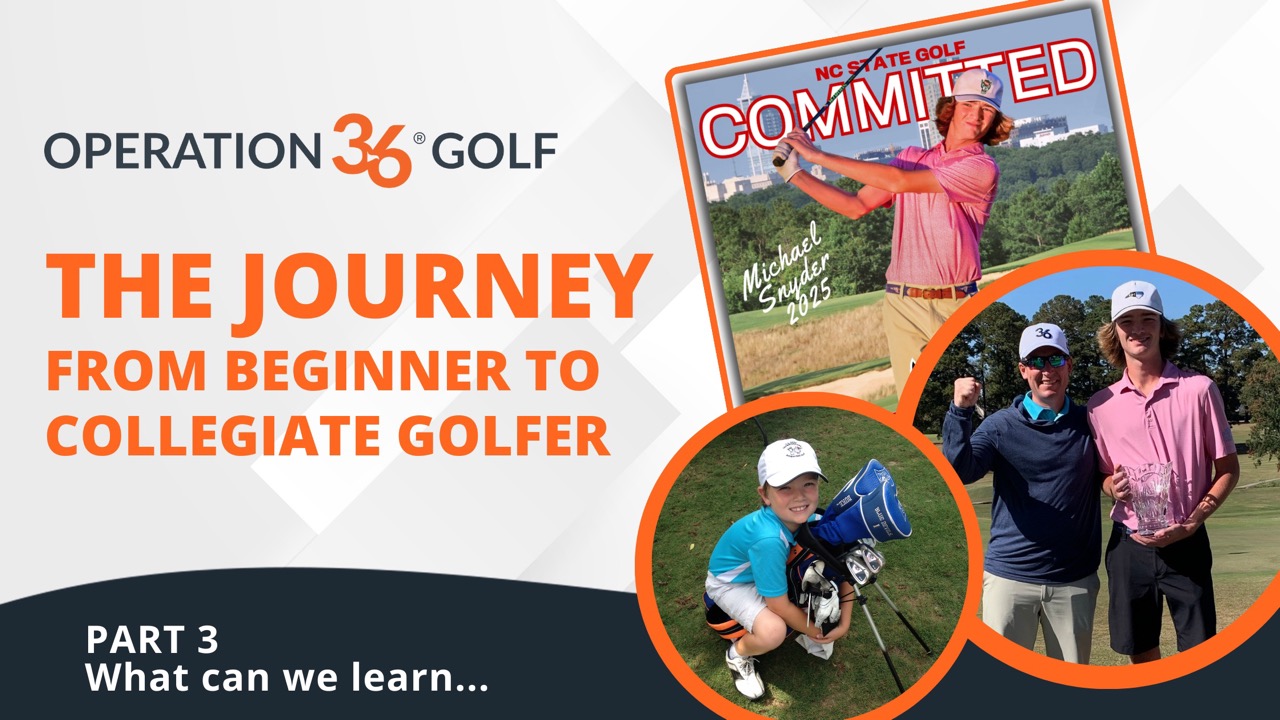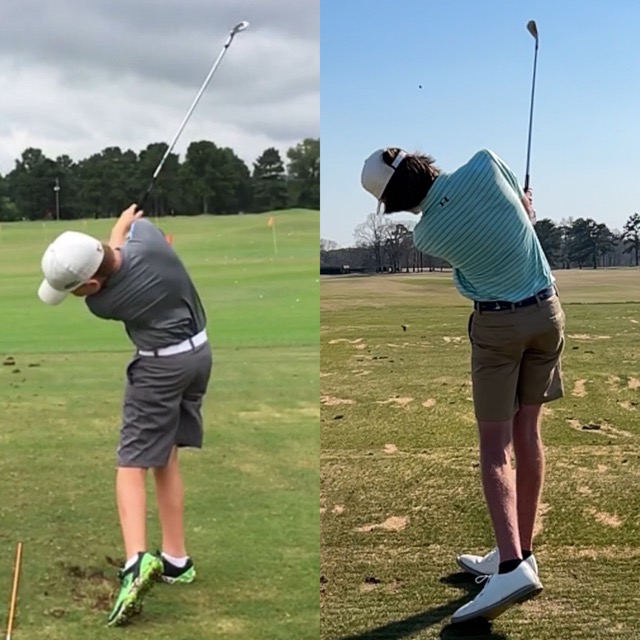
The final stage is referred to as the generalization stage. “Learners synthesize what they have learned with what they know and apply it to new contexts.” Of note for us as parents and coaches, players move up and down between the 3 stages of growth over time. Humans are not machines and we change on a daily basis at a cellular level. One could say we are not the same person day after day. 330 billion or 1% of our cells are replaced daily. In 80-100 days, all of our cells have been replaced and we are a ‘new’ person.

At times, Michael is in this 3rd stage, on autopilot and adapting what he’s learned to new courses, conditions, and competition. At times, he goes back into stage 2 and needs some guidance to sharpen something in his game that has gotten out of alignment. Players at the highest level go through the same cycle. That’s the importance of having a coach and team around you to help you. Michael learned early on the importance of a coach and he continues to this day to seek out help and coaching to help reach his potential.
Michael’s story could have had a different result.
I have observed countless players over the last 20 years who had as much talent as Michael or even more who did not reach the level of success that Michael has. Many of them quit the game entirely due to toxic environments that could have been avoided with some better golf programming and better decisions made by the Adults involved.
As a parent, please spend the time to research what program you are putting your child into. Ask questions, do a trial class, and observe what they do.
Traditional beginner golf programs are not great.
Lining up a beginner on the driving range, telling them all the things they are doing wrong in their swing, and then leaving them with a pile of golf balls to hit is not a recipe for success. They look around, see others having success hitting the ball high and far, and walk away wanting to do something else.
It’s weird to think about, but the traditional programs in golf avoid getting players on the golf course until they are ready. These programs don’t guide players into playing on the course, they leave that step to the player/family. In reality, playing on the course is what the program should be designed to do. Then, when they finish the program, they can participate in playing the game on their own and for a lifetime.
Picture a swimming class that never gets in the pool. They only work on their stroke on the deck of the pool each week and avoid getting in the water.
“Honey, do you need a towel to dry off after swim class? No Mom, we didn’t get in the pool.”

In defense of those who have walked before us:
The stewards of the game of golf are golf professionals. They typically juggle many different hats throughout their working day while managing a golf course. Creating a golf program designed for beginners is not on their normal list so they seek an easy solution. The easy solution has been either a 1-1 private lesson or a one-time group clinic on the driving range.
The vision for the future is that golf professionals and parents see the evidence of positive outcomes such as the one told in this article and gravitate towards a program like Operation 36 at their facility.
Don’t coach your child. Don’t do it.
Earl Woods, father of Tiger Woods and Richard Williams, father of Venus and Serena Williams are outliers amongst millions of children over the last 30-40 years.
I’ve seen way too many children’s curiosity and passion for the sport of golf destroyed by a parent who takes it upon themselves to coach their children. I am a golf professional of over 20 years and I defer the coaching of my kids in golf to someone else.
Your main role as a parent is to support and love your child no matter what outcomes they experience. When you start coaching and giving feedback, you put your child in a position where the only approval they will get from you is when they win. And it is natural for them to seek your approval and be proud of them.
In golf, you only win a very small percentage of the time. If you are their coach, they will only get your approval a few, if any, times a year….ouch.
From our statistics at Operation 36, if a player reaches a challenging Level, it will take around 20 attempts to score 36 or lower. That means, 19 times, or 95% of the time, they are not experiencing the thrill of victory. They are having very rich learning experiences that help them build the skills to beat 36. How do you help your child find fun in the 95% so they can learn and not quit?
Michael’s Mom and Dad might give us some clues into what we should consider doing as parents. Win, lose or draw, Michael’s Mom was always their at the end of an Operation 36 9-hole event to give him a hug. Michael’s parents and grandparents attended all 149 9-hole events he played in, I can’t recall them not being present. They would either walk on the cart path or drive a cart to support him. Amazing dedication…
If he had a tough round, his Dad would come up to us and give us some clues as to what he saw. He deferred the coaching to us and would routinely say, “I’m not a golf coach, I don’t know what to do, I’ll leave that up to you.”
His Grandfather would come up to me every few months and ask if Michael needs anything to help reach his goals. Sometimes it was a new pair of golf shoes as he had outgrown what he had, other times it was getting fit for updated clubs or whatever he needed. Michael had a fantastic support system.
Was Michael disappointed when he didn’t beat 36? Absolutely. Did his Mom and Dad feel the pain as well when he didn’t beat 36? Absolutely. Did we as coaches feel it? Yes. Their is no getting around that.

To his Mom and Dad’s credit, they leaned on the coaching staff to assist Michael and provided the love and support that only parents can provide. They made the 95% as enjoyable as they could for Michael and then they celebrated in the 5%.
For more information on parenting tips, please refer to, “How to Create a Junior Golfer,” a book we wrote in 2022 and will be updated later this year to the 2nd edition. Chapter 9 is dedicated to the Role of Parents and provides some additional content to assist parents. You can pick up a copy of this book at Amazon.
How to Create a Junior Golfer, by Ryan Dailey, PGA and Matt Reagan, PGA

Michael went from a beginner golfer in 2013 at the age of 6 to a top 2% golfer over the last 12 years.
What can we learn to help future parents and players? Here are 5 takeaways having been in the ring with him for 12 years as his Coach:
Conclusion:
We all need people in our corner who are supporting us and cheering us on as the road is full of bumps and potholes. Michael’s story gives us as coaches and parents a reference point we can draw on to inspire our players. I hope this gives you the motivation to support and cheer on your player.